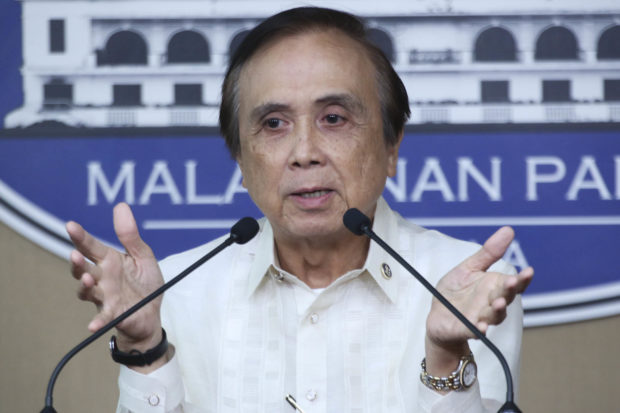PH economy grows 6.9%

Socioeconomic Planning Secretary Ernesto Pernia. ALBERT ALCAIN/Presidential Photo
The Philippine economy as measured by the gross domestic product (GDP) grew at a faster-than-expected 6.9 percent in the third quarter, making it one of Asia’s fastest growing.
Socioeconomic Planning Secretary Ernesto Pernia said the GDP expansion was a “spectacular growth rate after an election year.” GDP is the total value of goods produced and services rendered in a given period.
The year-on-year growth, which outpaced China’s 6.8 percent but trailed Vietnam’s 7.5 percent in the same period, was driven by strong industrial and services output, the National Statistics Office said on Thursday.
The growth in the July-September quarter surpassed a market consensus forecast of 6.6 percent and was an improvement on 6.7 percent growth in April-June.
It was, however, slightly lower than the 7.1 percent growth in July-September last year, just after the May elections.
Article continues after this advertisementAs a result of the better-than-expected growth, the peso strengthened to 50.9:$1 on Thursday from 51.04:$1 on Wednesday.
Article continues after this advertisementOverall, “we attribute the country’s growth performance to sustained strong growth in exports and improvements in public spending, which then boosted the manufacturing subsector and the services sector,” Pernia said in a media briefing.
Presidential spokesperson Harry Roque attributed the growth to the “stability” provided by the Duterte administration, which he said helped business in the country grow.
Full-year target
Pernia said the economy was on track to meet the government’s full-year growth target range of 6.5-7.5 percent, supported by higher state spending and improving exports and farm output.
President Duterte inherited a booming economy when he took office in May 2016. So far growth has remained on track, despite the country’s massive poverty, inequality and insurgencies.
On a per-sector basis, services contributed 4.2 percentage points; industry, 2.5 points; and agriculture, a mere 0.2 point.
In the third quarter, services grew 7.1 percent year-on-year, faster than that a year ago and a quarter ago.
Agriculture slows
The agriculture sector’s growth, however, slowed to 2.5 percent from 3 percent a year ago and 6.3 percent from the previous quarter.
Manufacturing output expanded 7.5 percent from a year earlier, while public consumption rose 8.3 percent thanks to increased pay and allowances for public employees, including the military, Pernia said.
“We are now seeing a sustained improvement in government spending in a run-up to our massive infrastructure program—the ‘Build, Build, Build’—which will continually unfold in the months ahead,” Pernia said. “This is expected to ratchet up public spending even further.”
Household consumption is also seen picking up in the last quarter due to the Christmas season, he added.
Rebound in exports
Like its peers in Asia, the Philippines is benefiting from the steady rebound in exports, which were up 12.2 percent in the nine months to September.
But economists have flagged Mr. Duterte’s war on drugs and “erratic policymaking” as potential risks that could weigh on investor sentiment.
“It is notable that foreign direct investment has dropped off this year, while investment growth has continued to weaken,” Capital Economics said in a note.
Growth in capital formation weakened to 6.6 percent in July-September, from 8.5 in the June quarter.
“Notwithstanding the continued political noise and the terrorist activity in Marawi, which President Duterte had decisively addressed, the economy managed to perform well in the third quarter as the government posted a double-digit increase in public investments and pursued initiatives to further improve fiscal health and boost investor sentiment,” Finance Secretary Carlos G. Dominguez III said.
Budget Secretary Benjamin E. Diokno pointed out that “in the past, economic growth usually takes a deep nosedive after an election year but this is not the case anymore owing to our sound macroeconomic fundamentals and economic policies.”
Too hot?
After the data’s release, Bangko Sentral Governor Nestor Espenilla sought to ease concerns of overheating.
“That begins to be a concern if we’re persistently growing above potential,” Espenilla told reporters. “To keep growing strongly without overheating, we expand potential itself—through high quality investments funded in a sustainable manner.”
He said the strong economic growth and “manageable inflation are in line with our expectations and validate current policy settings.”
Some economists, however, expect the central bank to raise the benchmark rate from the current 3.0 percent as early as next month to head off inflation, which has been creeping toward the upper end of the 2-4 percent target for 2017-2019.
The Philippines has posted more than 6 percent growth for nine consecutive quarters, making it among the fastest growing economies in the region.
Still, civil strife in Mindanao has taken a toll as seen in the dismal performance of the Philippine peso this year. Any delays in the government’s ambitious infrastructure program also could pose risks. —REPORTS FROM BEN O. DE VERA, PHILIP C. TUBEZA, AND THE WIRES